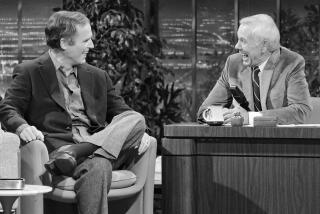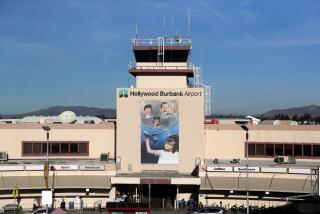Airport Officials Hopeful Despite USAir Departure : Burbank: Replacement of the weakened carrier with stronger ones could help the facility, an executive says. A new terminal is sought.
- Share via
Can an airport lose more than one-third of its passengers and be stronger for it?
In the wake of USAir’s pullout, Burbank Airport officials are seeking to portray their facility as being in just such a position.
If the departing carrier can be replaced with stronger ones, said one top official, “USAir’s leaving could prove to be a blessing.”
What is at stake is not the continued existence of the airport but officials’ long-sought goal of building a massive terminal so that the Burbank facility can take a place among the major airports of the nation.
Without that terminal, they say, Burbank is likely to continue much as it is--a small airport with a 61-year-old terminal serving a loyal but limited number of short-distance passengers, mostly commuters who crowd the facility immediately before and after office hours.
For expansion-minded officials, the numbers look unpromising: USAir, which will close its Burbank operations May 2, accounts for 1.2 million of the airport’s 3.5 million annual passengers and 22 of its 78 daily flights.
The departure puts Burbank further from the 5 million passengers a year needed to underwrite the cost of a new terminal, officials concede.
Also, the timing seems bad for finding a replacement airline. The airline industry has been especially hard hit by rising fuel prices, terrorism fears and costly fare wars.
“Despite all that,” said Robert W. Garcin, president of the Burbank-Glendale-Pasadena Airport Authority, which owns the airport, the departure of its largest carrier “could prove to be a blessing.”
Thomas E. Greer, the airport’s director, said investment bankers told him “that even with more than 30% of our market gone, we could be better off because now we can get healthy carriers to move in.”
The opinions of investment bankers are important to airport officials because they hope to sell up to $100 million in bonds later this year to buy land from Lockheed Corp. for the planned terminal.
Airport officials theorize that the facility’s balance sheet would look more attractive to lenders if its income is less reliant on a financially unstable USAir, which lost millions of dollars last year.
The issue of whether the airport is well to be rid of USAir turns on the much-debated question of whether the Arlington, Va.-based carrier is to blame for its own demise in the fiercely competitive intra-California market, or whether there merely are too many carriers chasing too few passengers in that market.
Since buying San Diego-based Pacific Southwest Airlines in 1987, USAir has been swimming in red ink on the California routes that it acquired.
Many blamed that on USAir’s relentless stamping out of PSA’s breezy management style, which encouraged female flight attendants to wear bright orange miniskirts and dress up as Christmas trees. Smiles adorned the noses of PSA airplanes.
USAir brought an all-business attitude to the once-carefree carrier.
Former PSA executives, many of whom were let go by the new employer, are in the forefront of those who argue that because of the change in corporate culture after 1987, customer loyalty dissipated.
But those who discount the importance of management styles point out that PSA reported losses every year from 1979 to 1986.
They also note that increased competition in California in recent years has forced USAir into an aerial dogfight for passengers.
The brawl for the Golden State market reached fever pitch in April when no-frills Southwest Airlines opened for business in Burbank with a one-way fare of $59 to the San Francisco Bay Area, contrasted with $164 for other airlines. Since then, one-way fares have plummeted to as little as $20.
In addition to pulling out of Burbank, USAir is abandoning five other California airports: John Wayne in Orange County, Ontario, Palm Springs, San Jose and Oakland.
The pullout all but undoes the $400-million purchase of PSA four years ago.
And USAir’s departure comes two weeks after American Airlines, which several years ago swallowed Air California, admitted that it was a loser in the fight for intra-California passengers and canceled most of its flights within the state.
With two of the major competitors gone, “fares will go up” within California, predicted Joe Brancatelli, editor of Frequent Flyer magazine.
But Burbank Airport officials contend that even if higher fares drive away some passengers, most of the 1.2 million people who flew USAir in or out of Burbank last year will switch to Southwest, Delta, Alaska or United airlines, four Burbank carriers that remain in the hunt for the intra-California flier.
“The strongest selling point of this airport remains convenience,” airport director Greer said. “There are 2.5 million people living within 15 miles of our front door. They will keep coming here.”
So far, no airline has petitioned airport officials for the terminal space that USAir is vacating, but Greer reported “some dialogue with several of them.”
Garcin, the authority president, said he would be surprised if would-be replacements appear eager for the space, thereby lessening their bargaining position.
“I think the next few months will tell,” he said, “and I’m cautiously optimistic.”
USAIR’S Share Burbank Airport operations Yearly passengers Total: 3.5 Mil. USAir: 1.2 mil. Daily Flights Total: 78 USAir: 22 PASSENGERS AT BURBANK AIRPORT Passengers per year (in millions) at Burbank Airport. Airport officials estimate that they need 5 million passengers per year to build the proposed new terminal.
1978 2.3
1979 2.4
1980 1.9
1981 1.9
1982 2.4
1983 2.8
1984 2.7
1985 2.9
1986 3.0
1987 3.2
1988 3.0
1989 2.7
1990 3.5
Source: Burbank-Glendale-Pasadena Airport Authority.
More to Read
Sign up for Essential California
The most important California stories and recommendations in your inbox every morning.
You may occasionally receive promotional content from the Los Angeles Times.










